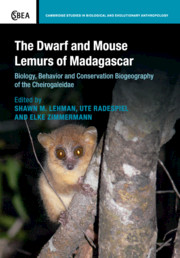 The Dwarf and Mouse Lemurs of Madagascar
The Dwarf and Mouse Lemurs of Madagascar Book contents
- Frontmatter
- Contents
- List of contributors
- Foreword
- Part I Cheirogaleidae: evolution, taxonomy, and genetics
- 1 Cheirogaleid diversity and evolution: big questions about small primates
- 2 The taxonomy of Cheirogaleidae: an ever-expanding species list
- 3 Mitogenomics of the family Cheirogaleidae and relationships to taxonomy and biogeography in Madagascar
- 4 Why cheirogaleids are bad models for primate ancestors: a phylogenetic reconstruction
- 5 Contact zones and species sympatry in dwarf lemurs (genus Cheirogaleus): the roles of ecological adaptation and sexual selection
- Part II Methods for studying captive and wild cheirogaleids
- Part III Cheirogaleidae: behavior and ecology
- Part IV Cheirogaleidae: sensory ecology, communication, and cognition
- Part V Cheirogaleidae: conservation biogeography
- Index
- Plate section
- References
3 - Mitogenomics of the family Cheirogaleidae and relationships to taxonomy and biogeography in Madagascar
from Part I - Cheirogaleidae: evolution, taxonomy, and genetics
Published online by Cambridge University Press: 05 March 2016
- Frontmatter
- Contents
- List of contributors
- Foreword
- Part I Cheirogaleidae: evolution, taxonomy, and genetics
- 1 Cheirogaleid diversity and evolution: big questions about small primates
- 2 The taxonomy of Cheirogaleidae: an ever-expanding species list
- 3 Mitogenomics of the family Cheirogaleidae and relationships to taxonomy and biogeography in Madagascar
- 4 Why cheirogaleids are bad models for primate ancestors: a phylogenetic reconstruction
- 5 Contact zones and species sympatry in dwarf lemurs (genus Cheirogaleus): the roles of ecological adaptation and sexual selection
- Part II Methods for studying captive and wild cheirogaleids
- Part III Cheirogaleidae: behavior and ecology
- Part IV Cheirogaleidae: sensory ecology, communication, and cognition
- Part V Cheirogaleidae: conservation biogeography
- Index
- Plate section
- References
Summary
Introduction
Due to its remarkable percentage of endemic species and the continuing pressure from human encroachment and poverty, Madagascar has been listed as one of the world's major biodiversity hotspots (Myers, 2000). The Malagasy strepsirrhine primates, the lemurs, are particularly susceptible to extinction due to anthropogenic activities (Jernvall and Wright, 1998). Taxonomic revisions and ensuing shifts in geographic distributions warrant the need to consistently re-evaluate the conservation status of lemur species as new information becomes available (Martin, 2000). In less than three decades, the number of described lemur species has grown dramatically, from 36 species in 1982 (Tattersall, 1982) to more than 100 species now (Tattersall, 2013; Thiele et al., 2013). This taxonomic increase, especially in the family Cheirogaleidae, is due to advancements in molecular genetic technology, as well as improvements in analytical tools and intensive field investigation (Tattersall, 2007; Thalmann, 2007; Mittermeier et al., 2008; Lei et al., 2012). Conservation decisions and priorities need to be regularly revised due to drastic habitat loss and changes in species distribution and abundances. This is especially true in the family Cheirogaleidae, which has been shown to harbor a large amount of cryptic species diversity.
Historical summary of Cheirogaleidae taxonomy and phylogeny
Cheirogaleidae (Gray, 1873) includes five genera: Microcebus, Mirza, Allocebus, Cheirogaleus, and Phaner, ranging in size from about 30 g to 600 g (Mittermeier et al., 2010). All cheirogaleid lemurs are nocturnal, move quadrupedally, and have elongated bodies and short legs. This family has experienced a dramatic increase in the number of recognized species, primarily within the genus Microcebus (Mittermeier et al., 2008). Initially classified as a single species, M. murinus (Miller 1777) was divided into two regionally defined species, M. murinus in the west and M. rufus in the east (Tattersall, 1982). In the last two decades, the genus Microcebus has expanded from 2 to 21 species based primarily on mitochondrial DNA (mtDNA) fragment sequences and morphological data (Schmid and Kappeler, 1994; Zimmermann et al., 1998; Rasoloarison et al., 2000, 2013; Kappeler et al., 2005; Andriantompohavana et al., 2006; Louis et al., 2006a, 2008; Olivieri et al., 2007; Radespiel et al., 2008, 2012).
- Type
- Chapter
- Information
- The Dwarf and Mouse Lemurs of MadagascarBiology, Behavior and Conservation Biogeography of the Cheirogaleidae, pp. 54 - 93Publisher: Cambridge University PressPrint publication year: 2016
References
- 10
- Cited by
